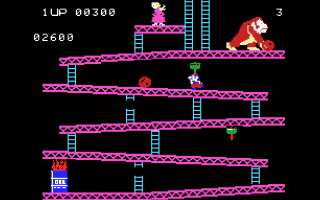 When
I was in grammar school, I knew a kid who looked a lot like an ape. His name was
Richard, and my friend Kevin and I would often refer to him as "Richard of
the Apes". Years later, when the game Crazy Kong turned up at my aunt’s
convenience store, I thought about Richard again and wished we were just a few
years younger so we could have called him "Crazy Kong" instead. Then
again, "Richard of the Apes" is still pretty funny. I wonder what he’s
doing now?
When
I was in grammar school, I knew a kid who looked a lot like an ape. His name was
Richard, and my friend Kevin and I would often refer to him as "Richard of
the Apes". Years later, when the game Crazy Kong turned up at my aunt’s
convenience store, I thought about Richard again and wished we were just a few
years younger so we could have called him "Crazy Kong" instead. Then
again, "Richard of the Apes" is still pretty funny. I wonder what he’s
doing now?
There are many ways to review a classic like this, I’ve chosen to skip past the game’s history and present and focus instead on the many home variations of Donkey Kong, which is in some strange way a brother to the game I saw first, Crazy Kong. You all know the story by now: A plumber named Mario is the hero. Kong is at the top of the screen keeping Mario’s girl hostage. Four screens appearing in various order depending on the machine you were playing, but always starting with the familiar girder and barrels scene. Mario navigates to the top avoiding barrels, fireballs, and hot plates of god-knows-what to reach the girl. When he does, Kong grabs the girl and heads up another level. It’s a lot like life. The big hairy guys just know how to get the job done.
 Donkey
Kong was produced for many home cartridge systems. Besides being the packed-in
game for the ColecoVision, cartridges were also made for the Atari VCS and 7800,
Intellivision, NES, Commodore 64 and VIC-20, TI-99/4A, and Atari 8-bit
computers. There’s a collecting goal for ya – do you have all of those? If
so, you know that they ALL play fairly well, but translate the original arcade
game quite differently. Let’s explore.
Donkey
Kong was produced for many home cartridge systems. Besides being the packed-in
game for the ColecoVision, cartridges were also made for the Atari VCS and 7800,
Intellivision, NES, Commodore 64 and VIC-20, TI-99/4A, and Atari 8-bit
computers. There’s a collecting goal for ya – do you have all of those? If
so, you know that they ALL play fairly well, but translate the original arcade
game quite differently. Let’s explore.
In the arcade version, Kong starts six girders high on the left. On the ColecoVision and Intellivision versions he starts five high and on the right. Many versions also attempted to render the playfield vertically, which makes the characters appear "fat" (not phat). Take a look at Mario on the C-64… man, that guy is HUGE! The hammers you use to knock out fireballs are almost always in the wrong places in the home versions as well, with only the C-64 and TI-99/4A getting it right consistently. Then there’s the issue of completeness, which was rarely met on the cartridge versions of the game. The hotplate-and-conveyors-screen is missing from most of them, even the "high-end" consoles. The VIC-20 cartridge suprisingly managed to include it even though the NES version did not. It also turned up on the Coleco ADAM "super" version of the game (which, suspiciously enough, can be dumped to a ColecoVision chip).
 So
how would "Richard of the Apes" feel about the monkey business that
transformed the home conversions? Well, he’d be quite happy, actually. Each
system performs well, within its limitations (except for the abysmal
Intellivision version). He’d choose the C-64 version as the best translation
overall because he doesn’t mind the fat juicy Mario. Personally, I’d have to
agree.
So
how would "Richard of the Apes" feel about the monkey business that
transformed the home conversions? Well, he’d be quite happy, actually. Each
system performs well, within its limitations (except for the abysmal
Intellivision version). He’d choose the C-64 version as the best translation
overall because he doesn’t mind the fat juicy Mario. Personally, I’d have to
agree.
